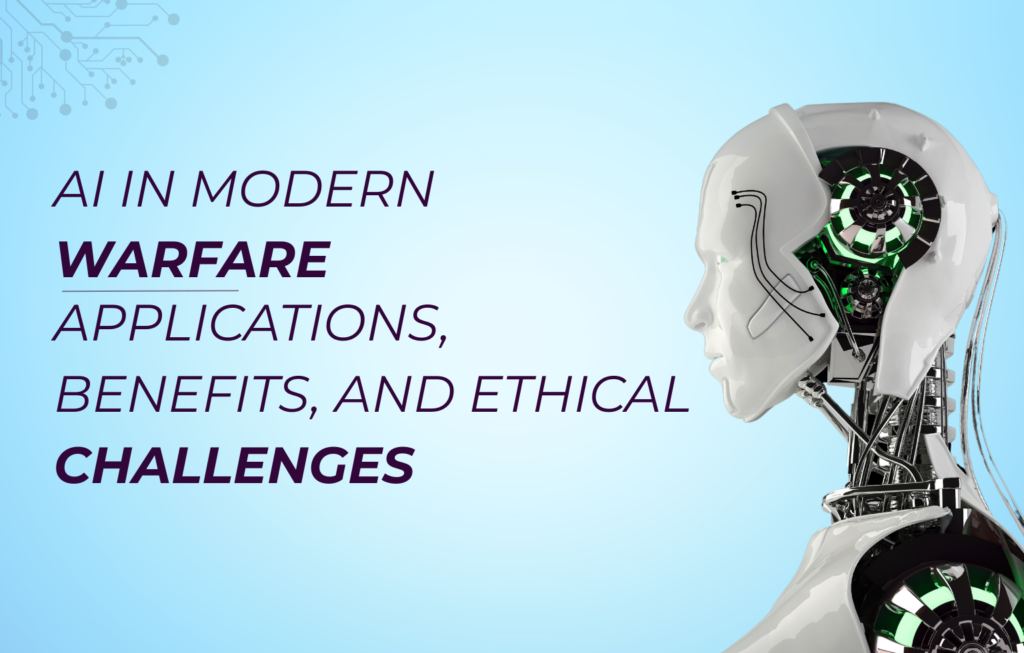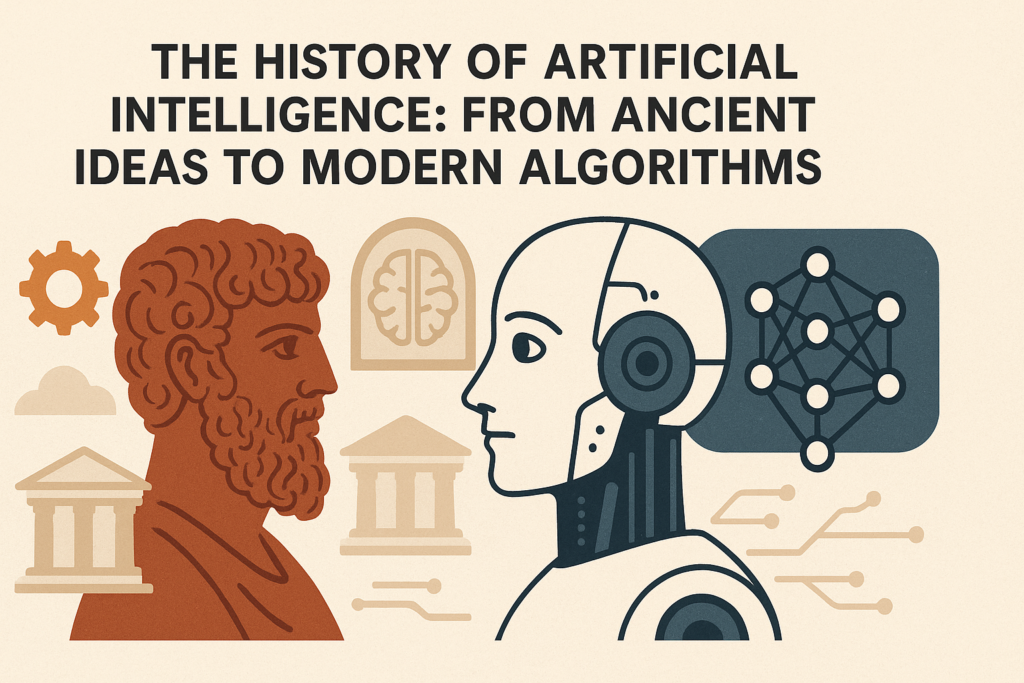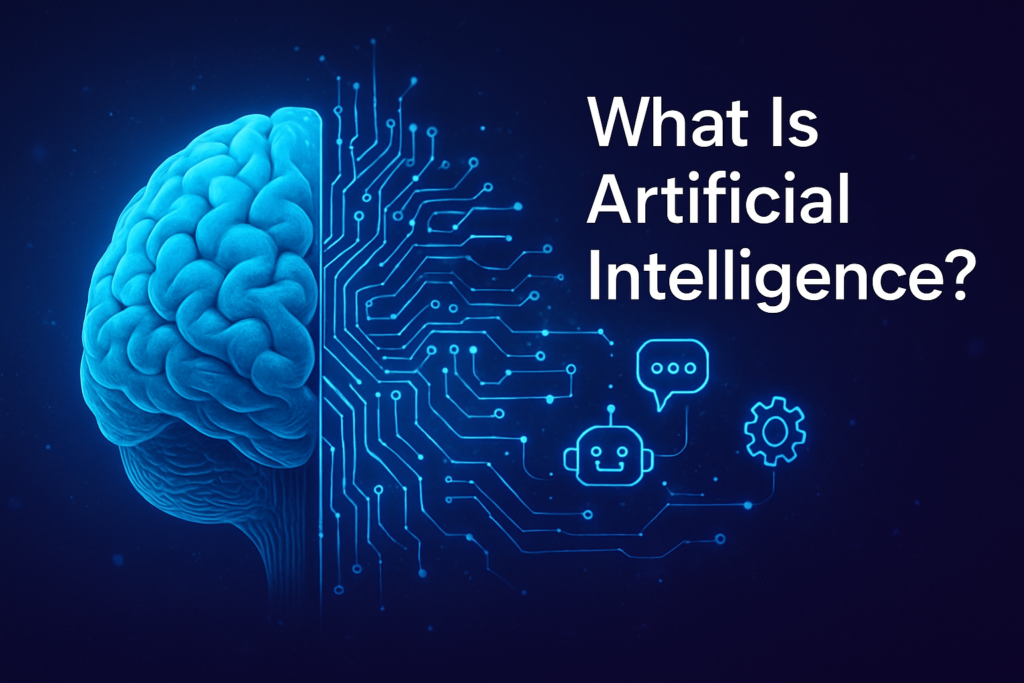Contents
- AI in Modern Warfare — Applications, Benefits, and Ethical Challenges
AI in Modern Warfare — Applications, Benefits, and Ethical Challenges
Artificial intelligence (AI) in warfare is rapidly transforming the landscape of modern military operations. From AI intelligence gathering to AI cyber warfare, military forces are increasingly leveraging advanced technologies to gain strategic advantages on the battlefield. Autonomous weapons systems, including AI-powered military drones, are revolutionizing combat by enabling faster, more precise strikes while reducing risks to human soldiers. These technologies enhance AI military decision making, allowing commanders to analyze vast amounts of data in real-time and respond swiftly to changing threats.
The importance of speed, intelligence, and precision in warfare has never been greater. AI for intelligence, surveillance, and reconnaissance (ISR) enables forces to monitor enemy movements, identify targets, and anticipate actions with unprecedented accuracy. However, integrating AI into military systems raises significant ethical concerns about AI in the military. Issues such as human control over autonomous weapons and the “black box” AI in military applications highlight the challenges of ensuring accountability and transparency.
This article explores the wide-ranging applications of AI in warfare, from AI logistics optimization in military operations to the growing risks of a military AI arms race. We will examine both the potential benefits and the critical ethical dilemmas posed by these powerful technologies, offering insight into the future of AI in armed forces worldwide.
1. The Rise of AI in Warfare
The evolution of military technology has always been driven by the need for greater speed, precision, and intelligence. From the invention of gunpowder to the development of radar and satellite reconnaissance, each advancement has fundamentally changed the way wars are fought. Today, the rise of AI in warfare represents the latest and perhaps most transformative leap in this ongoing progression.
AI’s ability to process and analyze massive amounts of data quickly is reshaping battlefield dynamics. AI intelligence gathering and AI for intelligence, surveillance, and reconnaissance (ISR) are enabling military forces to detect threats and make informed decisions faster than ever before. These capabilities provide commanders with enhanced situational awareness, which is critical in high-stakes environments.
Autonomous weapons systems are a prime example of AI’s transformative power. AI-powered military drones and other autonomous platforms can operate with minimal human intervention, improving both efficiency and precision in combat. AI military decision-making systems assist commanders by synthesizing complex information, reducing reaction times, and improving operational outcomes.
Furthermore, AI cyber warfare is becoming a vital front in modern conflicts. AI algorithms can detect cyber threats, defend networks, and execute offensive cyber operations, making cybersecurity a key component of military strategy. AI logistics optimization military functions also help streamline supply chains, ensuring that resources are allocated where they are needed most.
2. Specific Applications of AI in Warfare
2.1 Intelligence, Surveillance, and Reconnaissance (ISR)
One of the most critical applications of AI in warfare lies in intelligence, surveillance, and reconnaissance (ISR). AI systems are extensively used to analyze vast volumes of satellite imagery and open-source intelligence (OSINT), helping military forces gain real-time insights into enemy movements and battlefield dynamics. Advanced AI algorithms process and interpret complex visual data faster and more accurately than human analysts, enabling quicker identification of potential targets and troop deployments.
AI for intelligence, surveillance, and reconnaissance not only speeds up data analysis but also improves accuracy by reducing human error. Machine learning models can detect patterns and anomalies in large datasets, such as changes in terrain or unusual activity in specific locations. This capability is vital for target identification and tracking, ensuring that military operations are based on reliable, timely intelligence.
By automating routine surveillance tasks, AI allows human operators to focus on strategic decision-making. This enhances situational awareness and gives commanders a comprehensive picture of the battlefield, ultimately improving the precision and effectiveness of military actions.
2.2 Autonomous Weapons Systems
Autonomous weapons systems represent one of the most controversial and advanced uses of AI in modern warfare. These systems include unmanned aerial vehicles (UAVs), loitering munitions often referred to as “kamikaze drones,” and other AI-powered platforms capable of autonomous targeting and engagement without direct human control.
AI-powered military drones have revolutionized combat by enabling long-endurance missions with precise strike capabilities. These autonomous platforms can identify, track, and engage targets using onboard AI algorithms, reducing the need for continuous human oversight. Loitering munitions, which can hover over an area and strike when a target is identified, exemplify the fusion of AI and weaponry designed for rapid, precise attacks.
However, the autonomy of these weapons raises significant ethical and operational challenges. Human control over autonomous weapons is a key concern, as decisions made by AI systems may lack transparency or accountability—a problem often referred to as the “black box” AI in military applications. There is also the risk of malfunction or misidentification, potentially leading to unintended civilian casualties caused by AI weapons. Balancing the benefits of autonomous systems with these risks is a crucial challenge for military planners and policymakers.
2.3 Command and Control
AI and machine learning are increasingly integrated into command and control systems to support faster and more informed military decision making. AI and military decision support systems assist commanders by aggregating real-time data from diverse sources—satellite feeds, ground sensors, communications networks—and synthesizing this information to provide actionable insights.
These AI-driven tools help reduce the cognitive load on commanders, allowing them to focus on strategic objectives rather than sifting through overwhelming data streams. By enabling real-time data integration, AI enhances situational awareness and allows for rapid adaptation to evolving battlefield conditions.
This capability is vital in modern warfare, where the speed of decision making can be decisive. AI military decision making systems improve operational responsiveness and reduce human error, thereby increasing the effectiveness of military operations.
2.4 Cyber Warfare
AI plays a dual role in cyber warfare, enhancing both offensive and defensive capabilities. On the offensive side, AI algorithms can automate cyber attacks, identify vulnerabilities in enemy networks, and execute sophisticated intrusion techniques faster than human hackers.
Defensively, AI-enabled systems are critical for detecting and responding to cyber threats in real-time. Machine learning models analyze network traffic to spot anomalies indicative of cyber attacks, such as malware infiltration or phishing attempts. This proactive threat detection helps secure military networks against increasingly complex and persistent cyber threats.
AI cyber warfare capabilities also extend to identifying zero-day vulnerabilities and predicting future cyber threats. By continuously learning from attack patterns, AI systems can adapt and improve defense mechanisms, making them essential tools in maintaining cybersecurity for modern armed forces.
2.5 Logistics and Supply Chain Management
Military logistics and supply chain management benefit significantly from AI logistics optimization military tools. AI algorithms optimize the allocation of resources, route planning, and supply distribution to ensure that troops receive essential equipment and provisions efficiently.
By predicting demand, monitoring inventory levels, and adapting to changing battlefield conditions, AI helps reduce delays and waste. This optimization is crucial in sustaining prolonged military campaigns where supply chain disruptions can jeopardize mission success. Enhanced logistical efficiency provided by AI contributes directly to operational readiness and force effectiveness.
2.6 Signal Detection and Interception
Signal detection and interception are vital components of electronic warfare, and AI algorithms greatly enhance these capabilities. AI systems can analyze electromagnetic signals, radio frequencies, and communications data to identify transmissions of interest quickly and accurately.
By automating signal processing, AI helps in jamming enemy communications, intercepting covert transmissions, and gathering electronic intelligence. This capability improves battlefield situational awareness and can disrupt enemy command and control networks.
The speed and precision of AI-driven signal detection allow forces to respond swiftly to emerging threats and maintain an advantage in electronic warfare.
2.7 Cyber Security
AI-enabled cyber defense systems are central to protecting military infrastructure from sophisticated cyber threats. By employing pattern recognition and anomaly detection, AI models monitor network activity continuously, identifying unusual behavior that could indicate cyber attacks or breaches.
These systems use artificial neural networks trained on vast datasets of known attack signatures to detect and prevent emerging threats proactively. This real-time defense capability helps safeguard critical military communications, command centers, and weapons systems.
Additionally, AI-driven cybersecurity tools assist in incident response by automating threat mitigation, isolating affected systems, and reducing the impact of attacks. This dynamic adaptability is essential as cyber adversaries continually evolve their tactics.
Military reliance on AI cybersecurity technologies is increasing, reflecting the growing importance of securing digital assets in modern warfare. Effective AI cyber defense not only protects sensitive information but also maintains the operational integrity of armed forces worldwide.

3. Ethical Concerns of AI in Warfare
3.1 Reduced Human Control and Accountability — 200 words
One of the most pressing ethical concerns surrounding AI in warfare is the issue of reduced human control, particularly in autonomous weapons systems. As AI-powered military drones and other autonomous platforms gain the ability to select and engage targets without direct human intervention, questions arise about who bears responsibility for their actions. The concept of human control over autonomous weapons is critical to maintaining accountability in military operations.
When AI systems make lethal decisions independently, the chain of responsibility becomes blurred. If an autonomous weapon causes unintended harm or civilian casualties, it may be difficult to attribute blame—whether to the programmer, military commanders, or the AI itself. This lack of clear accountability raises serious moral and legal questions under international humanitarian law.
Moreover, reliance on AI decision-making support systems may cause commanders to overtrust machine judgments, potentially diminishing the role of human judgment in critical situations. Ensuring meaningful human oversight and control is essential to uphold ethical standards and prevent the dehumanization of warfare. Striking a balance between leveraging AI’s speed and precision and maintaining human responsibility remains a central challenge in the integration of AI in military operations.
3.2 Potential for Civilian Casualties — 150 words
While AI in warfare offers improved precision, there remains significant concern about civilian casualties caused by AI weapons. AI intelligence gathering and targeting can reduce errors, but the risk of collateral damage persists, especially in complex, dynamic combat environments.
Autonomous weapons systems, such as loitering munitions, rely on AI algorithms that may misidentify targets due to incomplete data or unforeseen circumstances. This can result in unintended strikes on civilian populations or infrastructure. Even minor errors can have devastating humanitarian consequences.
Ethical concerns of AI in military use include the objectification of human targets, where decisions are reduced to data points devoid of moral consideration. Ensuring that AI systems adhere to the principles of distinction and proportionality under the laws of armed conflict is critical to minimizing harm to non-combatants.
Developing robust safeguards, rigorous testing, and transparent accountability mechanisms is essential to prevent avoidable civilian casualties and maintain legitimacy in the use of AI-powered military technologies.
3.3 The "Black Box" Nature of AI — 150 words
The “black box” nature of AI in military applications presents a significant ethical challenge. Many AI algorithms, especially those based on deep learning, operate in ways that are difficult for humans to fully understand or explain. This opacity can hinder transparency and accountability, raising concerns about how decisions, particularly life-or-death ones, are made by AI systems.
When AI military decision-making relies on opaque processes, commanders and policymakers may be unable to verify or question the reasoning behind specific actions. This lack of clarity undermines trust and complicates efforts to ensure compliance with ethical and legal standards.
Furthermore, the complexity of AI decision support systems means that errors or biases embedded in training data may go undetected, potentially leading to flawed or unjust outcomes. Addressing the black box problem requires developing explainable AI models and robust auditing procedures to ensure that AI actions in warfare remain transparent and accountable.
3.4 Devaluation of Human Skills and Moral Agency
The growing reliance on AI in warfare raises concerns about the devaluation of human skills and moral agency among military personnel. As AI systems take over tasks like target identification, surveillance, and decision-making support, human operators may become overly dependent on technology, leading to skill degradation.
This dependency can erode critical thinking, situational awareness, and ethical judgment—qualities essential for responsible military conduct. When operators delegate lethal decisions to AI, there is a risk of diminishing their sense of moral responsibility, potentially creating psychological distance from the consequences of warfare.
Ethical concerns of AI in military use also highlight the danger of treating war as a purely technical problem, ignoring the human and moral dimensions of conflict. Preserving the role of human judgment and ensuring that operators retain agency over AI-enabled systems is vital to maintaining ethical standards and the humanity of warfare.
3.5 Potential for Escalation and Arms Race — 150 words
The rapid development of AI in warfare fuels concerns about an escalating arms race among global powers. Military AI arms race risks include the accelerated deployment of autonomous weapons systems and cyber warfare capabilities without sufficient international regulation or oversight.
Such an arms race could lower the threshold for conflict, as states may feel pressured to adopt AI technologies to maintain strategic parity or superiority. The speed and autonomy of AI-powered systems may also increase the risk of unintended escalation or accidental conflict, as machines act faster than human decision-makers can respond.
International diplomatic efforts are struggling to keep pace with the fast-evolving AI military landscape, raising urgent questions about how to establish norms, treaties, and controls to prevent destabilizing competition.
Addressing these risks requires coordinated global action to ensure that the deployment of AI in warfare does not undermine long-term international security and stability
4. Balancing Benefits and Risks: The Path Forward
As AI in warfare continues to advance, establishing robust ethical frameworks and oversight mechanisms is crucial to harness its benefits while minimizing risks. Clear guidelines on human control over autonomous weapons and transparency in AI military decision making can help ensure accountability and reduce unintended harm.
International law and diplomacy play a vital role in regulating AI’s military use, promoting cooperation to prevent a destabilizing military AI arms race. Agreements on the responsible development and deployment of AI-powered military drones, autonomous weapons systems, and AI cyber warfare capabilities are necessary to uphold global security.
Conclusion
AI in warfare is undeniably transformative, reshaping military operations through advancements in AI intelligence gathering, autonomous weapons systems, and AI military decision making. These technologies offer unprecedented speed, precision, and strategic advantage, enhancing everything from surveillance to cyber warfare. However, the integration of AI also brings significant ethical challenges, including reduced human control, the risk of civilian casualties, and the opaque “black box” nature of AI decisions.
Responsible use of AI in warfare requires a careful balance between leveraging its benefits and addressing these complex risks. Robust ethical frameworks, meaningful human oversight, and international cooperation are essential to ensure accountability and prevent destabilizing arms races. Ultimately, the future of AI in the armed forces depends on our ability to integrate cutting-edge technology with humanity’s core moral values and respect for international law.




